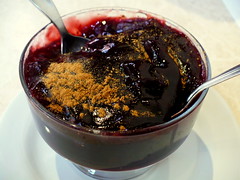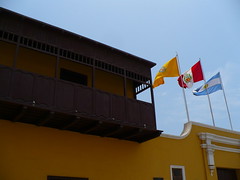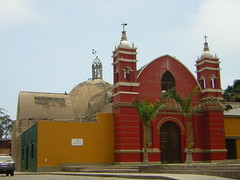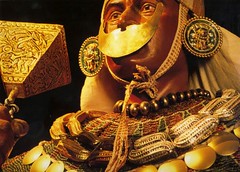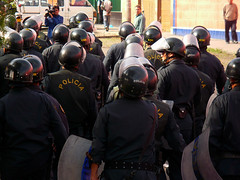Visit to an ostrich farm
Tom and Maribel visit Ricardo Castañeda’s ostrich farm near Chiclayo – perhaps the start of a booming industry in Peru. Ostrich meat is already considered a premium meat in several Lima restaurants.
Article brought to you by Mochica Hostess Tours
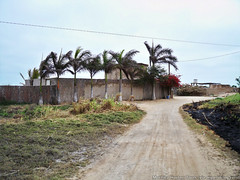 There is an interesting history and human interest story behind Ricardo’s Ostrich Farm. In 1990 Ricardo Castañeda resigned his position as a governmental administrator, moved from Chiclayo and became a sheep farmer. In a relatively short time he had a successful wool business, but in 1995 in an effort to stimulate the region’s economy the government distributed 10,000 sheep to several collective farms. The price of wool plunged and Ricardo as a private farmer was forced out of business; selling his sheep for $20 each after having paid $220 for them. Looking for a new business opportunity, he came across information on ostrich farming. The first obstacle was getting permission from the government to import and raise birds that have never before been in the country. After one and one-half years he was given permission, and selling all of his personal possessions, went to the States to ‘intern’ on an ostrich farm. In 1997 he was back in Peru with 11 baby birds. He has had several set-backs since then, including an incident in 2000 when a low flying plane frightened the birds and caused them to run into fences, injuring themselves. Twenty four of the injured birds had to be killed, but the business recovered and appears to be showing steady growth.
There is an interesting history and human interest story behind Ricardo’s Ostrich Farm. In 1990 Ricardo Castañeda resigned his position as a governmental administrator, moved from Chiclayo and became a sheep farmer. In a relatively short time he had a successful wool business, but in 1995 in an effort to stimulate the region’s economy the government distributed 10,000 sheep to several collective farms. The price of wool plunged and Ricardo as a private farmer was forced out of business; selling his sheep for $20 each after having paid $220 for them. Looking for a new business opportunity, he came across information on ostrich farming. The first obstacle was getting permission from the government to import and raise birds that have never before been in the country. After one and one-half years he was given permission, and selling all of his personal possessions, went to the States to ‘intern’ on an ostrich farm. In 1997 he was back in Peru with 11 baby birds. He has had several set-backs since then, including an incident in 2000 when a low flying plane frightened the birds and caused them to run into fences, injuring themselves. Twenty four of the injured birds had to be killed, but the business recovered and appears to be showing steady growth.

There were 102 very big birds resident on the day we visited Ricardo’s farm, located only 10 minutes by moto from the town of Pimentel. Seventy-two of them were ostriches and thirty were recently introduced emus. It will cost you $1.75 to tour the farm, but you’ll get a lengthy and complete tour by Ricardo’s son Luis plus the opportunity to feed alfalfa to the birds, like this big male who is not bashful about nearly wrenching your arm out of the socket and making you feel as if you’re being mugged rather than feeding Tweety.
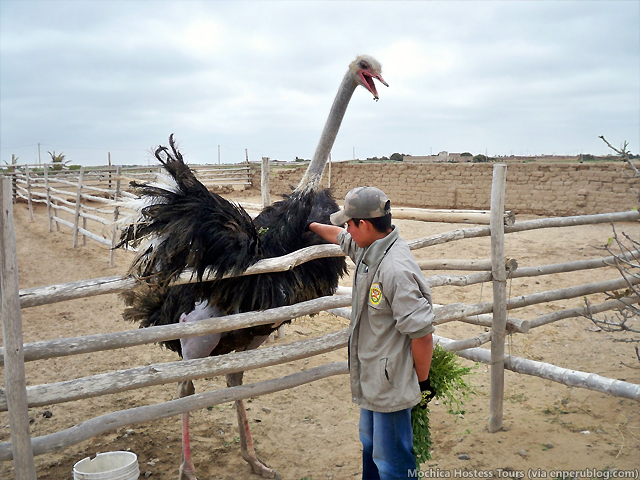
While he doesn’t mind being fed – in fact almost demands it, he will not tolerate being touched. He was not biting, but his wings were flared and he was delivering some thunderous kicks to the fence rails. They can kick with a lethal force of 500 pounds per square inch. They can also run at 40mph for over 30 minutes, so it’s not a good idea to irritate an ostrich. For me this guy’s only redeeming quality is those massive drum sticks, which are delicious….and relatively expensive by Peruvian standards.
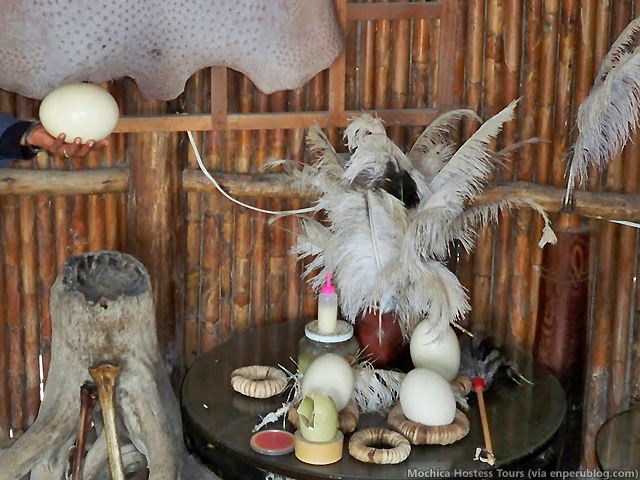
Ricardo’s sells ostrich meat to the public for $5.66 per pound. They also sell to one of the better restaurants in Chiclayo. An average ostrich weighs about 215 pounds and will yield about 50 pounds of meat; mostly thighs and loin, which translates to $283 for the meat value. In addition there is also income derived from the blood (food purposes), the oil rendered from fat (cosmetics), the skeleton which is reassembled and sold to university medical schools, and from the skin which is used to manufacture products such as shoes and purses. The feathers are used to make feather dusters and other items, so there is virtually no waste involved.
A hen ostrich can lay anywhere from 40 to 100 eggs annually, weighing from 3.5 to 5 pounds. The male ostrich digs a large depression in the ground where the female deposits the egg. Ricardo collects the eggs and transports them to an incubation facility in Chiclayo where they will hatch in 42 days. Three days later the chicks are returned to the farm. We didn’t see any young birds and neglected to ask where they were.

The emus are considerably smaller and less aggressive but their manners are not any better. Emu eggs are about 1/3 the size of an ostrich egg and are dark green in color. The meat is supposedly similar to ostrich, which in my opinion is very close to good beef. Ricardo does not plan on selling emu until their numbers have increased.
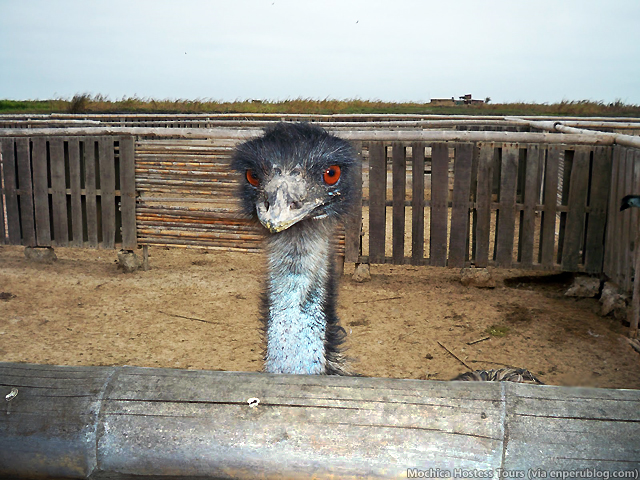
Each adult bird eats 4.5 pounds of feed each day, comprised of corn, rice and several types of seeds and beans. From the look on the face of this emu I’d say it didn’t get its share on this day.
One bit of advice if you visit the farm…ask the moto driver to wait for you. There is virtually no traffic on what amounts to the dirt path and it is a 30 minute walk at a steady pace back to town.
If you’d like to experience places like this and get a taste of real daily life in northern provincial Peru, speak to Tom & Maribel via Mochica Hostess Tours
There were 102 very big birds resident on the day we visited Ricardo’s farm, located only 10 minutes by moto from the town of Pimentel. Seventy-two of them were ostriches and thirty were recently introduced emus. It will cost you $1.75 to tour the farm, but you’ll get a lengthy and complete tour by Ricardo’s son Luis plus the opportunity to feed alfalfa to the birds, like this big male who is not bashful about nearly wrenching your arm out of the socket and making you feel as if you’re being mugged rather than feeding Tweety.
While he doesn’t mind being fed – in fact almost demands it, he will not tolerate being touched. He was not biting, but his wings were flared and he was delivering some thunderous kicks to the fence rails. They can kick with a lethal force of 500 pounds per square inch. They can also run at 40mph for over 30 minutes, so it’s not a good idea to irritate an ostrich. For me this guy’s only redeeming quality is those massive drum sticks, which are delicious….and relatively expensive by Peruvian standards.
Ricardo’s sells ostrich meat to the public for $5.66 per pound. They also sell to one of the better restaurants in Chiclayo. An average ostrich weighs about 215 pounds and will yield about 50 pounds of meat; mostly thighs and loin, which translates to $283 for the meat value. In addition there is also income derived from the blood (food purposes), the oil rendered from fat (cosmetics), the skeleton which is reassembled and sold to university medical schools, and from the skin which is used to manufacture products such as shoes and purses. The feathers are used to make feather dusters and other items, so there is virtually no waste involved.
A hen ostrich can lay anywhere from 40 to 100 eggs annually, weighing from 3.5 to 5 pounds. The male ostrich digs a large depression in the ground where the female deposits the egg. Ricardo collects the eggs and transports them to an incubation facility in Chiclayo where they will hatch in 42 days. Three days later the chicks are returned to the farm. We didn’t see any young birds and neglected to ask where they were.
The emus are considerably smaller and less aggressive but their manners are not any better. Emu eggs are about 1/3 the size of an ostrich egg and are dark green in color. The meat is supposedly similar to ostrich, which in my opinion is very close to good beef. Ricardo does not plan on selling emu until their numbers have increased.
Each adult bird eats 4.5 pounds of feed each day, comprised of corn, rice and several types of seeds and beans. From the look on the face of this emu I’d say it didn’t get its share on this day.
One bit of advice if you visit the farm…ask the moto driver to wait for you. There is virtually no traffic on what amounts to the dirt path and it is a 30 minute walk at a steady pace back to town.
Tags: chiclayo, farmers, lambayeque, ostrich, pimentel



